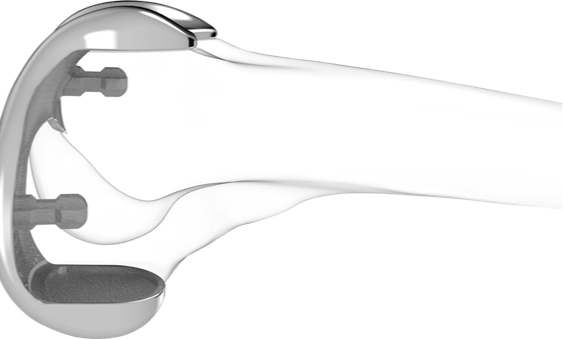Tibial and Femoral Fit Comparison: Conformis vs Generic Implants
Why is implant fit important?
10-15% of Total Knee Arthroplasty (TKA) patients have clinically significant residual pain after surgery.1,2
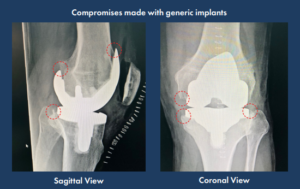
- Data suggests that 27% of clinically significant knee pain is attributable to femoral implant overhang.3
- Internal rotational errors, particularly of the tibial component, are a major cause of pain and functional deficit after TKA.4
Unlike generic implant systems, each Conformis implant and set of iJigs is designed with a personalized position, shape, and fit. This unique approach has resulted in over 94% patient satisfaction at one year post-op.5
Fit defined – femur
Generic total knee implants force compromises between adequate bone coverage, implant overhang, and implant underhang due to variations in patient anatomy.
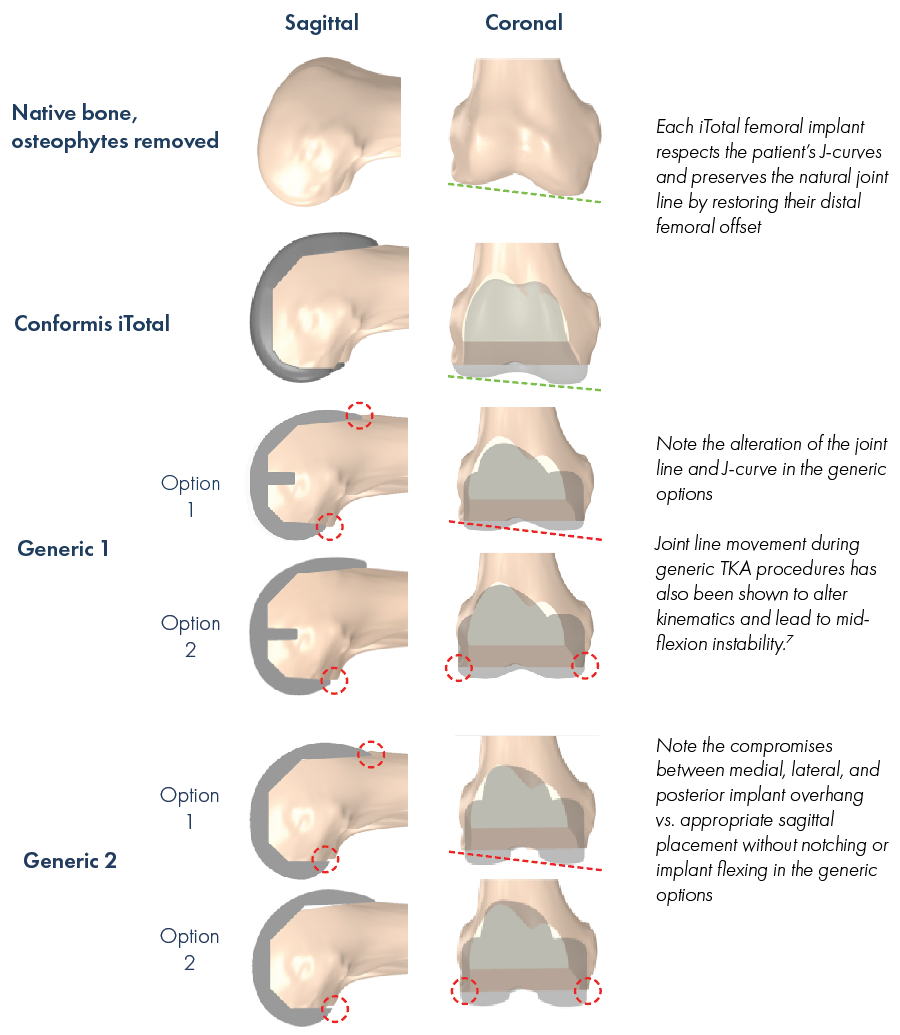
Fit defined – tibia
Generic tibial components force compromise between proper rotation and optimal bone coverage without cortical overhang.
Patients with internal component rotation are five times more likely to experience anterior knee pain and have patellar-femoral complications after TKA.4,9
A recently conducted study virtually compared the best fit placement of three generic knees compared to Conformis on 30 patients:
- Generic tibial components force compromise between proper rotation and optimal bone coverage without cortical overhang.
- Generic components were internally rotated an average of 9° due to compromises between fit and rotation10
- 70% of generic tibial components were placed in more than 5° of internal malrotation10
- Conformis components showed no rotational deviation10
Conformis utilizes the clinically proven Cobb method to properly rotationally align each iTotal tibial component.11 The patient-specific implant profile is designed to match the cortical rim of the bone, allowing 5° of intra-operative adjustment if desired without inducing implant overhang.
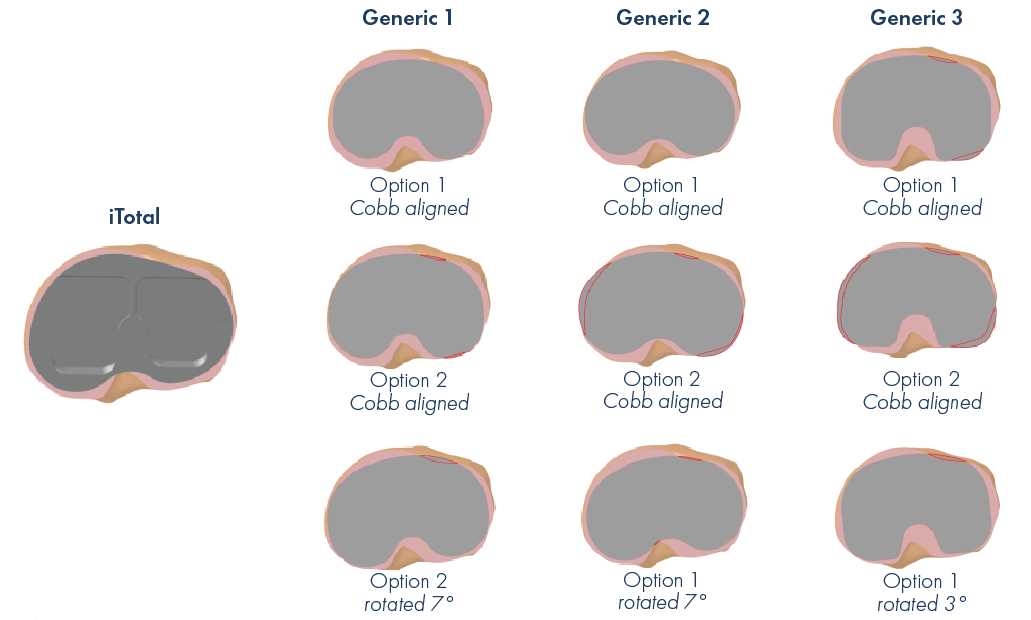
Fit achieved – iJigs
Generic total knee implants force compromises between adequate bone coverage, implant overhang, and implant underhang due to variations in patient anatomy.
Generic systems that utilize Patient-Specific Instrumentation (PSI) typically only set the distal femoral or proximal tibial resection depths.
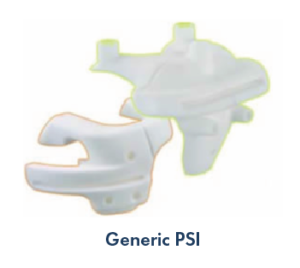
No correlation has been shown between generic PSI and improved patient outcomes after TKA12,13, as these instruments do not correct any issues found with generic implant fit.
Each Conformis case includes a comprehensive set of instrumentation, trials, and balancing tools called iJigs®. These instruments are 3D printed for each case based on that patient’s unique anatomy, and ensure that each implant is placed in its pre-determined location for optimized fit.

Better fit leads to better function
Conformis designs each implant and set of instrumentation based on that patient’s natural geometry to avoid known causes of post-operative pain and restore normal kinematics and stability. In a recent study comparing the Conformis iTotal system with a generic implant system:
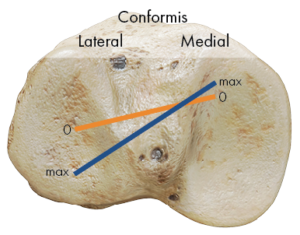
Conformis patients
- 91% experienced normal gradual rollback of the lateral
condyle - Condylar liftoff was recorded at 1mm or less throughout
range of motion
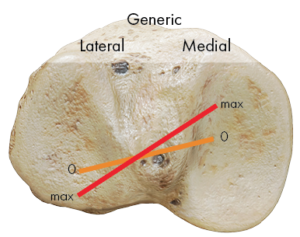
Generic patients
- No lateral condyle rollback
- 44% experienced anterior slide
- 56% experienced condylar liftoff of 1-3mm throughout range of motion.14
Improved form and fit leads to improved function and outcomes
This is not a new idea; it is reflected in the ever-expanding range of implant sizes and shapes available on the market today for generic implants. Conformis is the first and only company commercializing individualized anatomic total knee replacements.
We are driven by our conviction that surgeons and patients deserve something better than the limitations of generic implants; that a more advanced implant system gives surgeons the intra-operative freedom to apply his or her expertise at a higher level.
We believe that the future of successful knee arthroplasty lies in a skilled surgeon with a Conformis implant in his or her hands.
- Brander VA et al. Predicting total knee replacement pain: A prospective, observational study. Clin Orthop Relat Res. 2003;416:27-36.
- Katz JN et al. Association Between Severe Pain in the Early Months Following Total Knee Replacement and Functional Outcomes Over Five-Year Follow-Up. World Congress of OA. Abstract 80.
- Mahoney, et al; Overhang of the Femoral Component in Total Knee Arthroplasty: Risk Factors and Clinical Consequences. The Journal of Bone and Joint Surgery; 2010, 92: 1115-1121
- Berger, et al; Malrotation Causing Patellofemoral Complications after Total Knee Arthroplasty. Clinical Orthopaedics and Related Research; 1998, 356: 144-153
- Katthagen BD et al. Comparison of Hospital Metrics and Patient Reported Outcomes for Patients with Customized, Individually Made Vs. Conventional TKA. 2015 World Arthroplasty Congress (WAC).
- Barnes, C.L., Scott, R.D.; Popliteus Tendon Dysfunction Following Total Knee Arthroplasty; J Arthroplasty; 1995; Vol. 10; No. 4, pp. 543-545
- Martin J, Whiteside L. The Influence of Joint Line Position on Knee Stability After Condylar Knee Arthroplasty. Clin Orthop Relat Res 1990, 259, pp 146-156
- Patil, et al; Patient-Specific Implants and Cutting Guides Better Approximate Natural Kinematics than Standard Total Knee Arthroplasty. ORS Annual Meeting 2013, Vol.38. Abstract # 0965
- Barrack RL, et al; Component rotation and anterior knee pain after total knee arthroplasty. Clinic Orthop and Relat Res. 2001
- Martin S, Noble P. et al. Maximizing Tibial Coverage is Detrimental to Proper Rotational Alignment. Clinic Orthop and Relat Res (2014) 472:121–125
- Cobb JP; The Anatomical Tibial Axis – Reliable Rotational Orientation in Knee Replacement; J Bone Joint Surg [Br]; 2008;90-B:1032-8.
- Stronach BM, Pelt CE, Erickson JA, et al. Patient-specific instrumentation in total knee arthroplasty provides no improvement in component alignment. J Arthroplasty 2014;29:1705-8. 10.1016/j.arth.2014.04.025
- Abdel MP, et al; No Benefit of Patient-Specific Instrumentation in TKA on Functional and Gait Outcomes: A Randomized Clinical Trial. Clin Orthop Relat Res (2014) 472:2468–2476
- Kurtz, W., Et al.; “In Vivo Kinematics for Subjects Implanted With Either a Traditional or Personalized TKA”; 2014; ICJR; 2014 Pan Pacific Meeting
iTotal
The iTotal system offers two options that are both designed to restore the natural shape of a patient’s knee – iTotal CR and iTotal PS.
iTotalAbout Conformis
We start with a simple idea: make the implant fit the patient rather than force the patient to fit the implant
About Conformis

